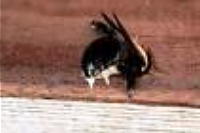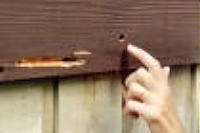CARPENTER BEES CAUSE STRUCTURAL DAMAGE - Extension Service Offers Advice


Have large black bees been hovering around eaves, decks and wood siding of your home and outbuildings? They are probably carpenter bees searching for mates and nesting sites.
Carpenter bees cause cosmetic and structural damage to wood. They can also be intimidating and have the potential to inflict painful stings.
The Problem
Carpenter bees are similar in appearance to bumblebees, but they have different nesting habits. Bumblebees generally nest in the ground; carpenter bees tunnel into wood to lay their eggs. Bare, unpainted, weathered softwoods are preferredâespecially redwood, cedar, cypress and pine. Painted or pressure-treated wood is much less susceptible to attack. Common nesting sites include eaves, fascia boards, siding, wooden shake roofs, decks and outdoor furniture.
Carpenter bees overwinter as adults in old nest tunnels. After mating, the fertilized females excavate galleries in wood, laying their eggs within a series of small cells. The cells are provisioned with a ball of pollen on which the larvae feed, emerging as adults in late summer.
The entrance hole and tunnels are perfectly round and about the diameter of your finger. Coarse sawdust, the color of fresh cut wood, is often seen beneath the entry hole, and burrowing sounds may be heard within the wood. Female carpenter bees may excavate new tunnels or enlarge and reuse old ones. Serious damage can result when the same piece of wood is worked year after year.
Males are often aggressive, hovering in front of people who are around the nests. The males are harmless, however, since they lack stingers. Female carpenter bees can inflict a painful sting, but they seldom will unless handled or molested.
The Solution
The best time to control carpenter bees is before the tunnels are fully excavated. For homeowners, liquid sprays of Sevin or a pyrethroid (such as Bayer Advanced⢠Home/Lawn & Garden Insect Killer, Spectracide® Triazicide/Bug Stop, Ortho®
Home Defense System/Termite & Carpenter Ant Killer) can be applied directly into nest openings. They also can be broadcast sprayed as a deterrent onto wood surfaces attracting large numbers of bees.
The broadcast spray approach is often warranted when carpenter bees are riddling siding on a barn, wood shake roofs, decking or similar large expanses of wood. Broadcast treatment is best accomplished with a pump up or hose end sprayer, targeting wood surfaces that are most favored by the bees (fascia boards, joist ends of redwood decks, etc.)
Residual effectiveness of such applications is only about one to three weeks. So, the treatment may need to be repeated. Individual holes can also be treated with a wasp and hornet aerosol spray or insecticide dust (such as Sevin, DeltaDust) directed into the nest opening.
Although carpenter bees are less aggressive than wasps, female bees provisioning their nests will sting. Consider treating at dusk or while wearing protective clothing.
Leave the holes open for a few days after treatment to allow the bees to contact and distribute the insecticide throughout the nest tunnel. Then plug the entrance hole with a piece of wooden dowel coated with carpenter's glue, wood putty or other suitable sealant. That will protect against future bees using the old tunnels as well as against moisture intrusion and wood decay.
Carpenter bees normally will not tunnel into painted wood. Therefore, a more permanent solution is to paint unfinished wood surfaces, especially those with a history of being attacked. Wood stains and preservatives are less reliable than painting, butâwhen compared to bare woodâ they may provide some degree of repellence.
To further discourage nesting, keep garages and outbuildings closed when carpenter bees are actively searching for nesting sites. The annoying flying and nesting habit usually subsides by the end of May.
In this article, trade or brand names were used for educational purposes only. The use of product names does not imply endorsement by the WVU Extension Service to the exclusion of other products that may be equally suitable.
For more information about safely managing home and garden pests, contact Jeff Himes, WVU Extension agent, at the Calhoun County office of the WVU Extension Service at Grantsville, or call (304) 354-6332.
Resource: The Timely Line News, Jackson County WVU Extension Service; adapted from "Managing Carpenter Bees" by Mike Potter, University of Kentucky.